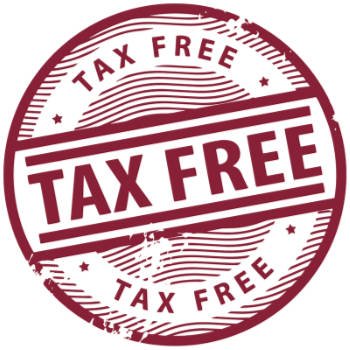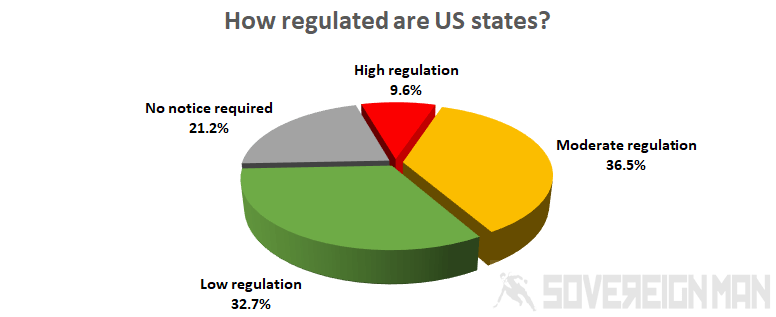Lowest Taxed States and
Homeschool Freedom 2023
-
AUTHOR
Harrison Burge -
PUBLISHED
March 29, 2021
Are you being overtaxed in your home state? And now that practically everyone can work from home 100% of the time, do you have the newfound flexibility to move to a lower-taxed jurisdiction?
Plus, if you’re considering a move to greener pastures, is homeschool freedom also important to your family? Instead of your child being subjected to a woke curriculum by out-of-touch teachers and administrators, you can take charge of your child’s education… with little to no interference from the state.
In this article, we’ll first discuss the best low-tax states. Because maybe low (or no) income tax, low property taxes and low sales tax are what’s most important to you. And you either don’t have kids, or plan to send your kids to good public or private schools in your new low-tax state.
Or, if you value both low income taxes and homeschool freedom, then we’ve also got you covered. We combed through the data and assembled a list of top 10 states that you can consider — places where you can save on taxes and freely homeschool your kids.
Looking for states where you can save on taxes? Or states where you can both save on taxes and freely homeschool your kids? If so, skip straight down to the respective section by clicking below.
Please note: The below content is intended for informational purposes only. We’re simply presenting the data, not making an official recommendation. Always consider what variables are most important to you.
One day, the two certainties in life — death and taxes — might need a revision…
Because at some point, we might have the option to upload our consciousness to the cloud…
But there’s no escaping the other inevitability. Taxes are here to stay. Federal income tax. State (or provincial) income tax. Even, in some cases, a city income tax. Payroll tax. Capital gains tax. Inheritance tax. Estate tax. Property tax. Sales tax.
Sure, local and state governments require taxes for essential services. But governments are not supposed to blanket every aspect of our lives.
Higher and higher taxes have enabled governments to grow, and high-earners have been hit the hardest. If you’re a high income earner, then between local, state and federal taxes, it’s likely that you’re handing over half or more of your earnings to the government.
And that comes with a huge opportunity cost.
Each dollar, pound, euro, etc. that’s sucked into government coffers means less capital available for individuals to direct as they wish — whether that’s through spending, saving, investing, building businesses, hiring more workers, increasing productivity or just generally raising the average standard of living.
And you don’t need to hold your breath: Most governments are not about to shrink in size anytime soon… especially in this post-pandemic world. In the bureaucrats and politicians’ eyes, the crisis continues ad infinitum.
And that means that governments now have a mandate, in their view, to spend money that doesn’t exist, and raise taxes to try to make up for budget deficits.
Translation: If anything, taxes are likely set to increase…
In mid-March 2021, the new US federal tax plan was rolled out.
This is the first major tax hike in nearly 30 years. It’s covering the whole gamut, and especially hammering high-income earners.
If kept in its current form and passed by Congress, we could see:

But wait, there’s more…
Because not to be outdone, some states could potentially hike state taxes, too…
For example, in New York state, there’s a proposal to raise $7 billion by taxing wealthy residents.
Here’s what the Empire State is proposing:
Factoring in local New York City taxes, high-income residents would pay the country’s highest combined income taxes.
These individuals — representing only 5% of filers — account for over 60% of the state’s revenue.
We’ll go out on a limb and predict that New York’s revenue will fall short of the expected $7 billion.
As long as moving to low-tax and zero tax states is possible, then off some people will go, along with their capital, and in some cases, their businesses…
In fact, wealthy New Yorkers are already high-tailing it out of Manhattan…
… And some are moving to Florida, with a concentration in the Miami area, which is quickly becoming a new high-tech and finance hub.
Data from 2021 reveals that 9% of former Manhattanites moved to Miami Dade and Palm Beach counties. Last year, that number was 6%.
Texas is another popular destination for high income earners from New York and California.
In late 2020, former Californian, founder of SpaceX, and CEO of electric car manufacturer Tesla, Elon Musk, moved to Austin, Texas.
And Tesla is building a factory there.
Musk is not alone. The CEO of file sharing company Dropbox has joined Elon in Austin. And companies like Hewlett Packard and Oracle are leaving the Bay Area for Texas, too.
Florida and Texas are no-brainer options for these companies and wealthy individuals. Both have strong economies and no state income tax.
Of course, you don’t have to be a billionaire to enjoy those perks. And you don’t have to limit yourself to Florida or Texas. Aside from these two states, there are seven others that have no state income tax…

Below we’ll present both the low income tax states and those with no income tax, starting with the latter…
These 9 states have no income tax
The following are the nine US states with no income tax, along with information on each state’s sales tax, and average property taxes, as of November 21, 2022.
| State | State sales tax | State sales tax on groceries | State sales tax on prescription medication | Average property tax |
|---|---|---|---|---|
| Alaska | 0% | 0% | 0% | 1.19% |
| Florida* | 6.00% | 0% | 0% | 0.89% |
| Nevada | 4.60% | 0% | 0% | 0.60% |
| New Hampshire | 0% | 0% | 0% | 2.18% |
| South Dakota | 4.50% | 0% | 0% | 1.31% |
| Tennessee | 7.00% | 5.50% | 0% | 0.71% |
| Texas | 6.25% | 0% | 0% | 1.80% |
| Washington | 6.50% | 0% | 0% | 0.98% |
| Wyoming | 4.00% | 0% | 0% | 0.61% |
* Florida’s state sales tax is 6% on most items, but 6.75% on electricity and 5.5% on commercial leases.
These 8 states have a state income tax of less than 5%
There are all sorts of ways of defining a state as “low tax”.
Does a “low tax” state mean one that boasts a “low” state income tax? And what does “low” actually mean? The same concepts also apply to property tax and sales tax.
Usually, it’s not property tax or sales tax that accounts for your highest level of fiscal sacrifice. Instead, it’s the state’s income tax. That’s why we chose to focus on income tax over property or sales tax.
With that said, here are the states that levy an income tax of 5% or less…
| State | State income tax | State sales tax | State sales tax on groceries | State sales tax on prescription medication | Average property tax |
|---|---|---|---|---|---|
| North Dakota | 2.90% | 5.00% | 0% | 5% | 0.98% |
| Pennsylvania | 3.07% | 6.00% | 0% | 0% | 1.58% |
| Indiana | 3.23% | 7.00% | 0% | 0% | 0.85% |
| Michigan | 4.25% | 6.00% | 0% | 0% | 1.54% |
| Colorado | 4.55% | 2.90% | 0% | 0% | 0.51% |
| Ohio | 4.80% | 5.75% | 0% | 0% | 1.56% |
| Illinois | 4.95% | 6.25% | 1% | 1% | 2.27% |
| Utah | 4.95% | 4.85% | 3% | 0% | 0.63% |
How about a 4% corporate tax and 0% capital gains/dividend tax?
If you’re a US citizen, you know that moving from one state to another is not complex: Just pack your belongings, cross state lines, and get settled in your new home.
Moving to Puerto Rico is no different.
So, if you’re considering a move from, say, California to Texas for the tax benefits, why not at least consider Puerto Rico’s amazing tax incentives?
Puerto Rico is a commonwealth of the United States. But if you move there and establish bona fide residency, then you become subject to the island’s tax system. In other words, US federal tax rules largely don’t apply to you.
The first incentive is Puerto Rico’s 4% corporate tax rate.
This is enshrined in Act 60, Chapter 3 (previously known as Act 20, the Export Services Act). If you own a business or work as a freelancer or contractor who provides some type of service to clients outside of Puerto Rico, then you can incorporate in Puerto Rico and enjoy this tax benefit.
Plus, thanks to Act 60, Chapter 2 (previously known as Act 22, the Individual Investor Act), you can distribute corporate dividends to yourself completely tax-free. (Or if you’re a trader or investor, your capital gains are also tax-free.)
You’ll still need to pay yourself a “reasonable” salary, which is subject to federal payroll taxes and Puerto Rico’s income tax. But “reasonable” in Puerto Rico is often much lower than in the US mainland.
Puerto Rico is one of the only options for US citizens to legally escape most federal taxation.
If you’d like more information on Puerto Rico’s tax incentives and our insider’s scoop on the best places to live on the island, visit this link.
Learn EVERYTHING you need to know about the BEST places to live, when you move to Puerto Rico…
Download our FREE guide, and dive into:

This 32-page report (with pictures) is brand new and absolutely free.
Aside from taxes, there’s another good reason to move away from New York state…
The homeschooling requirements are stringent:
Clearly, in New York, there’s not really much “home” in homeschooling; you’re subject to the dictates of state bureaucrats and administrators. And New York is not alone in inserting itself into your classroom.
But, fortunately, there are some states on the opposite side of the spectrum. These are places where you – the parent – are truly in charge of your child’s education, and no state bureaucrats or school administrators will meddle with your family’s schooling choices.
States range from high regulation levels, like New York, to “no notice” required for homeschooling (i.e. the freest or best option for parents seeking to homeschool their kids).
“No notice” means that if you never enroll your children in school, you don’t have to inform the state that you are homeschooling. Generally, though, you do have to formally withdraw your child from public school if you intend to switch to homeschooling.
States without any notice requirement include:

Next are the “low regulation” states.
In these states, you’ll generally need to register your intent to homeschool with the local school district before the school year in which your child turns six or seven. This requirement varies by state, so check the specific laws and regulations in your state (or the state you may be moving to).
But besides registration, there are generally very few other requirements in “low regulation” states.
States with “moderate” regulation require registration, often every year. They also generally have testing requirements.
And finally, states with “heavy” regulation generally require registration, testing, and submission of an annual syllabus that aligns with subjects taught by the state — and sometimes even proof of immunizations.
Good news: As the chart below shows, over 50% of US states are categorized as either “no notice” or “low regulation”.

Homeschooling outside the United States
If you’re thinking about living abroad with your family and value homeschooling freedom, you may or may not be able to legally homeschool your child everywhere.
Canada, Great Britain, Australia, and parts of Central and South America allow homeschooling. But in countries such as Germany, Romania, Bulgaria, and Slovakia, for example, it’s illegal.
And to be precise: A country’s education laws apply to all children who reside there, regardless of whether or not those children are citizens.
You’ll need to review each country’s laws. The section below lists an excellent resource to help you get started.
Homeschooling resources for both US and international parents
The Home School Legal Defense Association (HSLDA) is an organization that fights for homeschooling freedom.
They take on cases where government officials overstep their bounds.
And although based in the United States, the HSLDA assists with international homeschooling as well.
Visit their site — again here — to kick off your research.
The list of the 11 freest homeschool states above might be a good start when choosing a new home.
But not all states on that list offer low income taxes.
Iowa, for example, levies an 8.53% state income tax on incomes over $75,420. (That applies whether you’re single, married and filing jointly, married and filing separately, or filing as head of household.)
Ideally, you may want to choose a state that offers both homeschool freedom and low or zero income taxes. If so, we present…
So, without further ado, here’s our top 10 list of lowest-taxed, freest homeschooling states in the US…
| State | Level of homeschooling freedom | Top state income tax bracket | State sales tax1 | Average property tax |
|---|---|---|---|---|
| Alaska | “No notice” required (1/4) | 0% | 0% | 1.19% |
| Texas | “No notice” required (1/4) | 0% | 6.25% | 1.80% |
| Nevada | Low regulation (2/4) | 0% | 4.60% | 0.60% |
| Wyoming | Low regulation (2/4) | 0% | 4.00% | 0.61% |
| Indiana | “No notice” required (1/4) | 3.23% | 7.00% | 0.85% |
| Michigan | “No notice” required (1/4) | 4.25% | 6.00% | 1.54% |
| Illinois | “No notice” required (1/4) | 4.95% | 6.25% | 2.27% |
| Oklahoma | “No notice” required (1/4) | 5.00% | 4.5% | 0.90% |
| Missouri | “No notice” required (1/4) | 5.40% | 4.225% | 0.97% |
| Idaho2 | “No notice” required (1/4) | 6.93% | 6% | 0.69% |
1 Not including state sales tax on groceries and prescription medication, if applicable.
2 As of March 2021 (as we’re writing this article), the Idaho House has approved a reduction in income tax from 6.93% to 6.5%.
Our methodology to determine the top 10 states
If you’re curious about our methodology, here’s how we assembled our top 10 list. We:
As of April 2021, the following nine US states have no income tax: Alaska, Florida, Nevada, New Hampshire, South Dakota, Tennessee, Texas, Washington and Wyoming.
As of April 2021, the following US states don’t have any notice requirement for homeschooling: Alaska, Connecticut, Idaho, Illinois, Indiana, Iowa, Michigan, Missouri, New Jersey, Oklahoma and Texas.
As of April 2021, the following US states have the highest income tax rates:
Each state in this list has a personal income tax floor, with applicable tax exemptions, deductions, credits, and specific definitions of what constitutes taxable income. In combination, these factors determine what its citizens actually end up paying in taxes.
As of April 2021, the following nine US states have no state taxes: Alaska, Florida, Nevada, New Hampshire, South Dakota, Tennessee, Texas, Washington and Wyoming
It’s 2021. You’re not a medieval serf, forever tied to the land where you were born.
And with the rise of remote work starting in 2020, chances are you finally have the opportunity to head to greener pastures…
A place where you can save big on taxes. A place where you can more freely homeschool your children. Or a place where you can enjoy both these benefits.
We encourage you to consider what’s most important to you (and if applicable, your family). Dig into the free resources that we provided in this article…
And then take action to maximize your freedom and prosperity.
Learn EVERYTHING you need to know about the BEST places to live, when you move to Puerto Rico…
Download our FREE guide, and dive into:

This 32-page report (with pictures) is brand new and absolutely free.
Download Our Free Perfect Plan B Guide
Download our free Perfect Plan B Guide and learn no-brainer strategies on how to legally reduce your taxes including…

How Business Owners and Self-Employed Professionals can legally slash their tax bills up to 1.2 million each year.
With minimal changes to their business AND without moving abroad
You’ll also learn many other useful strategies such as how to generate strong investment returns while taking minimal risk, and how to obtain a valuable second passport.
Legal Disclaimer:
Neither this document, nor any content presented by our organization, is intended to provide personal tax or financial advice. This information is intended to be used and must be used for information purposes only.
We are not investment or tax advisors, and this should not be considered advice. It is very important to do your own analysis before making any investment or employing any tax strategy. You should consider your own personal circumstances and speak with professional advisors before making any investment.
The information contained in this report is based on our own research, opinions, as well as representations made by company management. We believe the information presented in this report to be true and accurate at the time of publication but do not guarantee the accuracy of every statement, nor guarantee that the information will not change in the future.
It is important that you independently research any information that you wish to rely upon, whether for the purpose of making an investment or tax decision, or otherwise.
No content on the website (SovereignMan.com) or related sites, nor any content in this email, report, or related content, constitutes, nor should be understood as constituting, a recommendation to enter into any securities transactions or to engage in any of the investment strategies presented here, nor an offer of securities.
Sovereign Man employees, officers, and directors may participate in any investment described in this content when legally permissible, and do so on the same investment terms as subscribers. Sovereign Man employees, officers, or directors receive NO financial compensation from companies who appear in this report.
Join over 100,000 subscribers who receive our free Notes From the Field newsletter
where you’ll get real boots on the ground intelligence as we travel the world and seek out the best opportunities for our readers.
It’s free, it’s packed with information, and best of all, it’s short… there’s no verbose pontification here– we both have better things to do with our time.
And while I appreciate all the visitors who stop by our website, I provide special bonuses to our email subscribers… including free premium intelligence reports and other valuable content that I only share with them.
It’s definitely worth your while to sign-up, and if you don’t like it, you can unsubscribe at any time.
How did you like this article?
Click one of the stars to add your vote...
Other readers gave this article an average rating of 4.9 stars.